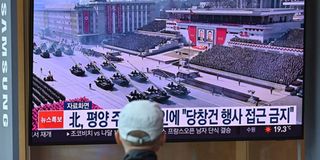North Korea defies coronavirus with huge military parade

A man watches a television news broadcasting a file footage of a military parade showing North Korean soldiers and weapons, at a railway station in Seoul on October 10, 2020.
What you need to know:
- The widely anticipated display is part of commemorations of the 75th anniversary of the North's ruling Workers' Party.
- North Korean military parades normally climax with whatever missiles Pyongyang wants to highlight and are keenly watched by observers for clues to its weapons development.
Seoul,
Nuclear-armed North Korea held a giant military parade Saturday, television images showed, with thousands of maskless troops defying the coronavirus threat and Pyongyang expected to put on show its latest and most advanced weapons.
The widely anticipated display is part of commemorations of the 75th anniversary of the North's ruling Workers' Party.
State broadcaster KCTV showed squadron after squadron of armed soldiers and armoured vehicles lined up in the streets of Pyongyang ready to march through Kim Il Sung square in a night-time display.
None of the participants or the audience lined up in the stands were wearing masks, but there were far fewer citizens than usual on the square itself.
The programme opened with an image of a propaganda poster for the commemorations, showing three North Koreans holding up its symbols of a hammer, sickle and brush, and the slogan: "The biggest glory to our great party."
North Korean military parades normally climax with whatever missiles Pyongyang wants to highlight and are keenly watched by observers for clues to its weapons development.
According to Seoul's joint chiefs of staff, the display actually took place in the early hours of Saturday, when they said in a statement that "signs of a military parade -- involving equipment and people on a large scale -- were detected at Kim Il Sung Square".
South Korean and US intelligence agencies were "closely tracking the event", they added.
Tough year
The ruling party anniversary comes during a difficult year for North Korea as the coronavirus pandemic and recent storms add pressure to the heavily sanctioned country.
Pyongyang closed its borders eight months ago to try to protect itself from the virus, which first emerged in neighbouring China, and has yet to confirm a single case.
Last month, troops from the North shot dead a South Korean fisheries official who had drifted into its waters, apparently as a precaution against the disease, prompting fury in Seoul and a rare apology from North Korean leader Kim Jong Un.
The North is widely believed to have continued to develop its arsenal -- which it says it needs to protect itself from a US invasion -- throughout nuclear negotiations with Washington, deadlocked since the collapse of a summit in Hanoi early last year.
Analysts expected a new submarine-launched ballistic missile (SLBM) or an intercontinental ballistic missile (ICBM) capable of reaching the US mainland to appear -- maybe even one with multiple re-entry vehicle capabilities that could allow it to evade US defence systems.
The anniversary of the Workers' Party means North Korea "has a political and strategic need to do something bigger", said Sung-yoon Lee, a Korean studies professor at Tufts University in the United States.
Showcasing its most advanced weapons "will signal a big step forward in Pyongyang's credible threat capabilities", he said.
No foreigners
But unlike on many previous occasions, no international media were allowed in to watch the parade, and with many foreign embassies in Pyongyang closing their doors in the face of coronavirus restrictions, few outside observers were left in the city.
Foreigners were not welcome at the anniversary commemorations, according to the Russian embassy in Pyongyang, which posted a message from the authorities on its Facebook page urging diplomats and other international representatives not to "approach or take photos" of the venues.
At the end of December, Kim threatened to demonstrate a "new strategic weapon", but analysts say Pyongyang will still tread carefully to avoid jeopardising its chances with Washington ahead of next month's presidential election.
Showing off its strategic weapons in a military parade "would be consistent with what Kim Jong Un promised", said analyst Lee, while "not provoking the United States as much as a test-launch of a strategic weapon".
But Harry Kazianis of the Center for the National Interest warned that if thousands of people were involved, it could turn into a "deadly superspreader-like event" unless "extreme precautions" were used.
The impoverished nation's crumbling health system would struggle to cope with a major virus outbreak, and he added that such protective measures seemed "pretty unlikely".
"Clearly, masks and missiles don't mix," he said.





